If you have been flying a drone or following our industry for any amount of time, you're probably familiar with the term 'Remote ID.' As part of the European Union's latest drone regulations, the Remote ID requirement has been enacted throughout the EU, Liechtenstein, Iceland, Norway, and Switzerland.
The main thing you need to know is this: All drones operating in the specific category and/or with class marks operating in the open category must now be equipped with Direct Remote ID. This criteria spans the vast majority of operations. In this blog, we will summarize Remote ID, outline the European Union's approach, and share everything you need to navigate compliance for European operations.

The European Union Aviation Safety Agency's Remote ID Rules
We will start with the European Union Aviation Safety Agency's (EASA) incoming Remote ID rules.
All drones operating in the specific category or with class marks operating in the open category must now be equipped with Direct Remote ID. For those that do not have remote identification capabilities, third-party modules accepted and tested by the EASA must be attached to your aircraft.
Next, we will go into more detail on Remote ID and the steps you need to take to ensure compliance.
What Is Remote ID?
The best way to think of Remote ID is as a digital license plate for your drone. EASA requires the ability to remotely identify aircraft to ensure the safety and accountability of drone operations. With more drones in our skies, it is essential that law enforcement have the information they need to identify unauthorized flights in restricted areas and maintain airspace safety.
Because pilots are remote and there is often a significant distance between the aircraft and the relevant authorities, a smart, connected solution is needed. That system is Remote ID.
How Does Remote ID Work and What Data Is Transmitted?
Regulators worldwide have explored different models for remotely identifying drones and settled on Broadcast Remote ID (also known as Direct Remote ID). This method involves drones sending signals that nearby receivers can pick up. This broadcast is one-way, does not target a specific receiver, and is therefore accessible to anyone in the vicinity with appropriate equipment.
So what about the data that is broadcast? The EASA now requires that your drone transmit the following information:
- Drone Operator Registration Number: This is a unique identifier for the drone operator, assigned upon registration with the relevant national authority.
- Drone Identification Number: A unique identifier for the drone itself, usually a serial number compliant with standard ANSI/CTA-2063-A.
- Geographical Position, route course, and speed of the Drone: Latitude, longitude, route course, ground speed, and altitude of the drone's current location.
- Geographical Position of the Pilot: Latitude, longitude, and altitude of the pilot or, if not available, the take-off point.
- Time Stamp: Information about the time the data was recorded or broadcasted.
- Drone emergency status: an indication of the emergency status of the drone.
Remote ID In Europe
All drones operating in the specific category and all drones with class marks operating in the open category must now be equipped with Direct Remote ID. To determine whether that applies to you, we will quickly review two essential features of the EASA's drone regulations: registration and categorization.
Registration & Categorization
To help establish accountability and better integrate drone operations into shared airspace, most drone operators in Europe have to go through a registration process. Although EASA's regulations cover all member states, pilots must register with their country's national aviation authority.
Whether you need to register depends on the weight of your drone and its capabilities. The only circumstances in which you don't need to register are:
- If your drone weighs less than 250 grams and has no camera or sensor to capture personal data.
- If your drone weighs less than 250 grams and has been classified as a toy.
Pilots will receive a registration number that is valid across Europe. This number must be physically displayed on your aircraft and entered into your drone's Remote ID system. The other factor impacting your Remote ID obligations in Europe is how your drone/operation is classified. Under EASA regulations, drones and drone operations are designated into different classes and categories according to weight, capability, and intended use.
There are a few limited exceptions to the Remote ID requirement:
- Class 0 drones: These drones have a maximum take-off weight of less than 250 grams, including payload.
- C3 drones that are tethered: These drones must meet specific criteria, including having a tether length of less than 50 meters.
- C4 drones with no automatic control modes: These drones must not have any automatic control modes other than flight stabilization. This exception is intended for model aircraft enthusiasts.
To learn more about C2 label certification, read our Enterprise Insights blog here.
Complying with Remote ID
Pilots operating in the European Union must take the following steps to ensure compliance with the EASA's Remote ID requirement:
1. Registration: Register with the national aviation authority in your country. This involves providing personal details and receiving a unique operator ID.
2. Mark Your Drone: Clearly mark your drone with your operator ID. This ID must be visible on the drone.
3. Ensure your drone is equipped with the necessary Remote ID technology. You can do this by:
- Purchasing a new drone that comes with built-in Remote ID capability.
- Retrofitting your existing drone with a Remote ID module if it does not have built-in capabilities.
- Installing firmware updates: For drones capable of Remote ID but require firmware updates, make sure to install these updates to enable the feature.
4. Upload your Operator Registration Number (ORN) to the EASA's Remote ID System. Use your DJI App - either DJI Fly or DJI Pilot 2 - to upload the ORN issued by your national aviation authority.
How to Upload Your ORN Number to Remote ID System
1. In the Home screen of your DJI app (take the DJI Pilot 2 as an example here), click on the Geo Zone map in the upper left corner.
2. After entering the Geo Zone Map, click the RID button at the bottom of the screen.
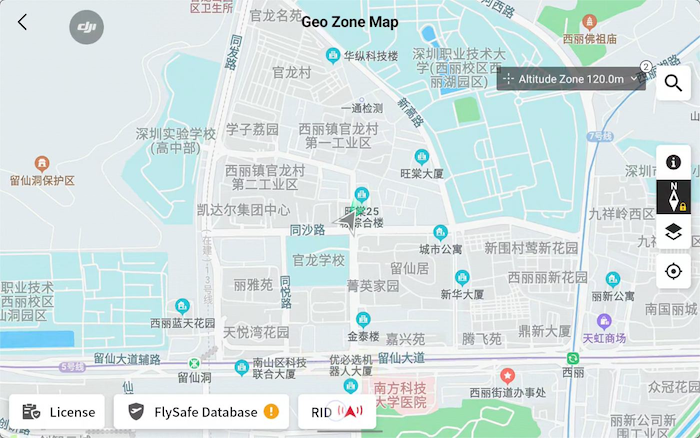
3. Go to the RID details page and click on the ORN to add yours.
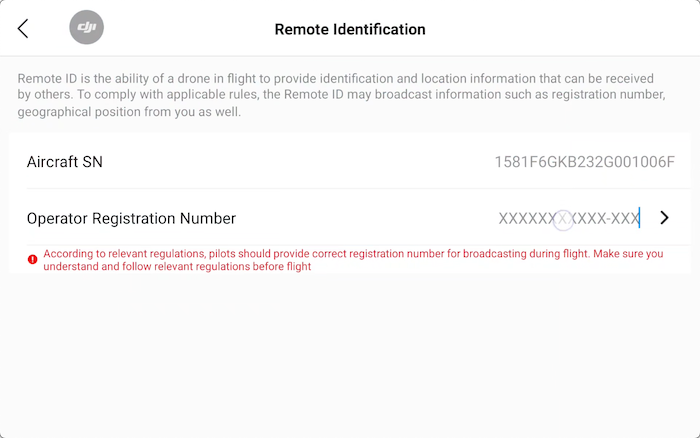
4. Enter your ORN, click OK, and it will automatically synchronize to your aircraft.
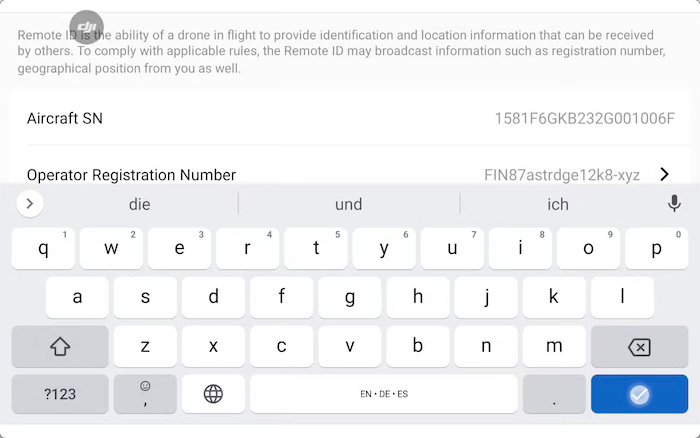

Once complete, the RID icon on the app home page turns black. You can follow the same process to edit, delete, or replace your ORN.
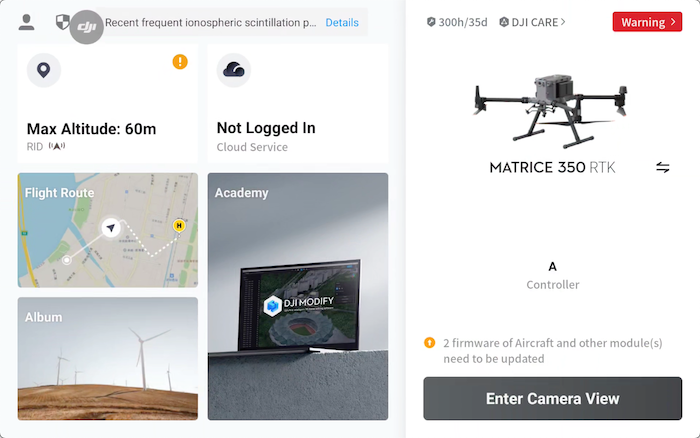
Which DJI Enterprise Drones Have built-in Remote ID Capabilities?
- M30 / M30T Dock
- M30 / M30T
- M350
- M3 E/T/M
For older DJI models not on the list above, operators must purchase third-party modules to enable Remote ID. The EU Declaration of Conformity List shows which Remote ID module manufacturers have been certified. For more information on EASA certifications and a list of third-party modules that provide remote identification in line with the 'EU Declaration of Conformity', click here.
How Do I Know If My Enterprise Drone's Remote ID Functionality Is Working Properly?
1. Check the Remote ID status display on the DJI flight control app.
In DJI Pilot 2, if Remote ID is working correctly, the RID icon in the upper left corner of the DJI Pilot 2 homepage will be displayed in black, and DJI Pilot 2 will display "Normal" on the Camera View, as shown below.
Map View:
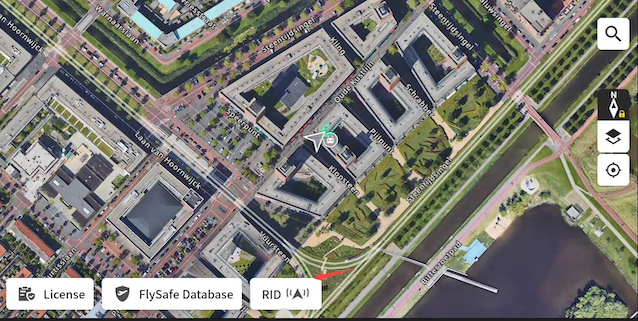
Camera View:

If your aircraft's Remote ID is working abnormally, the RID icon in the upper left corner of the DJI Pilot 2 homepage will be displayed in red, and an error will be displayed on the Remote ID setup page.

2. Check WLAN to see if RID is broadcasting.
You can also check local WLAN networks to see if your Remote ID serial number is broadcasting. Use the DJI remote controller to start the drone’s motors and then check for local WLAN networks.
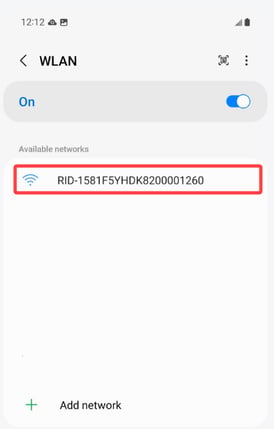
If you can see a string prefixed with “RID-” followed by a 20-digit alphanumeric Remote ID serial number in the "Available networks", it means that the Remote ID is working correctly.
Which DJI Consumer Drones Have Built-in Remote ID?
Remote ID regulations also apply to consumer drones. These DJI models have built-in R-ID capabilities:
- Mini 4 Pro (With C1 certification)
- Air 3
- Mavic 3 Pro / Cine
- Mavic 3 Classic
- Mavic 3 / Cine
Where Can I Learn More?
You can read through the EASA’s complete drone regulations and Remote ID legislation here.


.png?width=300&name=L3kv%20(1).png)

.png?width=300&name=FH2%20update%20(1).png)
-1.png?width=300&name=HS%20-%20Featured%20Images%20(3)-1.png)